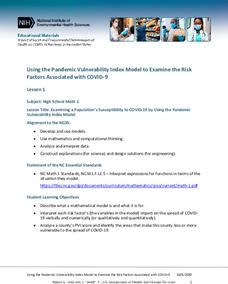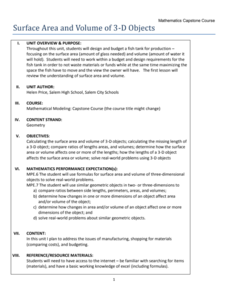Teach Engineering
Capillarity – Measuring Surface Tension
How do cohesion and adhesion work together? The third installment of a nine-part series teaches young scientists the difference between adhesion and cohesion. They also learn how cohesion and adhesion work together to cause capillary...
Houghton Mifflin Harcourt
Unit 5 Math Vocabulary Cards (Grade 6)
Acute angle, line of symmetry, and vertex are a few terms you'll find in a set of 90 flashcards designed to reinforce math vocabulary. Included in the set are two types of cards; a word card printed in bold font, and a definition card...
Curated OER
Measuring Speed With iMovie
Students record each other running, walking, throwing a ball, or doing a similar activity for a set distance. They import the video clips into iMovie. They compute how long it took in miles per hour.
Curated OER
Comparing
Practice the comparison words lighter, heavier, longer, shorter, smaller, and bigger using this visual chart. For each set of three objects, pupils order them according to one of these terms. The six terms are illustrated above for...
Curated OER
Liters and Millilitres
Have your class show what they know about liters and millilitres. This quiz game asks several questions related to converting millilitres to liters and fraction, decimal equivalency. A super fun way to review!
Curated OER
Unit IX: Worksheet 3 - Impulsive Force
Eight motion-related problems are contained in this physics assignment. Upcoming physicists calculate combined velocity after collisions, impulse, and momentum. They also address critical thinking situations, making this a well-rounded...
NASA
Write the Book on Weather Metrics
It's not easy to measure the weather. Pupils learn about what all weather has in common—the atmosphere. Scholars discover how a meteorologists must be able to measure aspects of the atmosphere and decipher the data. They then create a...
Houghton Mifflin Harcourt
Use a Graph: Measure Fish
Something's fishy here! Use the bar graph provided to determine the length of each fish shown. Small cartoon fish make this an engaging worksheet for young learners. There are six questions provided.
Las Cumbres Observatory
The Cosmic Distance Ladder: Parallax
Scientists don't have a ruler long enough to measure to the stars, so they rely on math. Scholars learn to calculate the distance from Earth to a star using the parallax method. They use angle measures from different perspectives to...
Flipped Math
Properties of Parallel Lines
Work within a parallel universe. Scholars learn about the relationships of angles when two parallel lines are intersected by a transversal. They see how to find the measurements of all eight angles by knowing the measure of one angle....
Beyond Benign
PPM
The 15th lesson in the series of 24 helps your classes understand the ppm (part per million) unit of measure. First, scholars experiment with food coloring to determine concentrations before applying their findings to calculate...
National Institute of Environmental Health Sciences
Lesson 1: Using the Pandemic Vulnerability Index Model to Examine the Risk Factors Associated with COVID-19
How vulnerable are you to COVID-19? High school mathematicians use the Pandemic Vulnerability Index to create models that help them collect and analyze data about the risk factors associated with COVID-19. After investigating four groups...
University of Colorado
Designing an Open Spectrograph
Take the class over the rainbow. Pairs or small groups follow directions to create a spectrograph. The pupils measure the angles formed by the different colors of the spectrum along with calculating the lengths formed by the spectrum and...
Exploratorium
Life Size - Explore the Size and Scale of Microscopic Biology
Compare sizes of microscopic items. Given a set of labels of microscopic objects, pupils try to place them in order from smallest to largest. Scholars then compare their lists to the actual comparisons along with the measurements of the...
Levin Institute
Unit on Culture and Globalization
Students explore the concept of cultural globalization. In this global issues lesson, students read and discuss the linked Web articles about world cultural issues and the dominance of the American market.
University of Wisconsin
Infiltration Test: Exploring the Flow of Water Through Soils
Soil scientists gain experience with an infiltrometer can to determine the infiltration rates at different locations on campus. If you are using the entire unit, the class has already analyzed water flow and soil types, so they should...
Project Maths
Inequalities
Which number is bigger? Using a variety of activity sheets, this unit starts with the basics of inequalities and progresses through solving compound linear inequalities. Problems cover the range of inequalities including inequality word...
Statistics Education Web
The United States of Obesity
Mississippi has both the highest obesity and poverty rate in the US. Does the rest of the data show a correlation between the poverty and obesity rate in a state? Learners tackle this question as they practice their skills of regression....
Radford University
Surface Area and Volume of 3-D Objects
Don't let the class tank the project. After reviewing formulas for surface area and volume, pupils design fish tanks that maximize volume. They research cost of materials online and must meet a budgetary constraint when creating their...
Bonneville
Electrical Energy and Solar Module Efficiency
It's much more efficient if everyone knows the relevant terms. Pupils research vocabulary terms related to electric currents to start a unit on solar energy. They then use a multimeter to measure the voltage and current for a solar...
Workforce Solutions
Human Knot
Employability skills are difficult to measure but are essential in the workplace. Introduce high schoolers to employability skills with the Human Knot activity. Groups of six grab hands to form a human knot and untangle themselves. The...
Purdue University
Well-Being: Dimensions of Wellness
New ReviewA unit on well-being begins with participants completing a self-assessment worksheet. After reflecting on the results, individuals set well-being goals for themselves that are SMART (Specific, Measurable, Attainable, Relevant, and...
Sea World
Seals, Sea Lions, and Walruses
Learn about the mammals of the sea with a lesson about seals, sea lions, and walruses. Kids study the characteristics of each pinniped with flash cards and information, and then analyze data about elephant seals, measure heat loss in...
Other popular searches
- Customary Units of Measurement
- Nonstandard Measurement Units
- Si Units of Measurement
- Standard Units Measurement
- Measurement Units
- Arbitrary Units Measurement
- Standard Units of Measurement
- Converting Measurement Units
- Customary Units Measurement
- Historic Units of Measurement
- Linear Units of Measurement
- Basic Units of Measurements

























